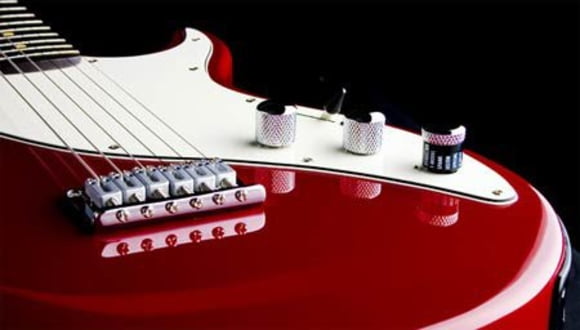6. Modelling Guitars
Modelling guitars and basses are instruments whose sound is produced by integrated electronics, not the acoustic or electrical properties of the instrument itself. Synth sounds usually play little or no role here; these instruments are concerned with simulating the sounds of important guitar models such as the Les Paul, Strat and Tele (even offering several versions/vintages of each) as well as additional sounds such as acoustic guitars, banjo and twelve-string.
A modelling guitar is not a MIDI guitar. Modelling guitars output the sound of a guitar from a regular jack socket, not signals that need to be converted by a guitar processor. The output from a modelling guitar may be connected directly to a guitar amp, while the output of the pickup of a MIDI guitar controller must be connected to a guitar processor or synth.
The leading company in the field of modelling guitars is Line 6, a California-based company which has pioneered the use of digital modelling technology in guitars, amplifiers and FX processors. Their first modelling amplifier was patented in 1996. Their Variax line of modelling guitars has become popular with guitarists; an easy way to spot a Variax guitar is that it has no visible conventional pickups. The Variax features many guitar sounds and familiar controls, and uses hexaphonic piezo pickups, so each string is individually processed. One benefit of this is that since each string is modelled separately, tunings may be switched instantaneously via footswitch. These guitars feature a digital output along with the standard quarter-inch jack, allowing direct connection to Line 6 amps or pedals, so that presets can be changed across all units with one button press. These instruments need power, either using internal batteries from a Line 6 amp or pedal board.

Variax acoustic modelling guitars are available in both steel- and nylon-strung versions and offer various features across the range including an integrated tuner, reverb, chorus, alternative tunings and models of rare and expensive instruments such as 12-string acoustics, sitar, shamisen and dobro. When using the alternate tunings, remember to set your amplified signal loud enough to mask the sound you hear from the guitar itself. These weight and feel of these guitars weigh is close to a solid body guitar. Because the cavity is smaller, they dont produce a lot of acoustic volume, so while they may be perfectly suited for the stage or studio, they may not work as well at around a campfire.
Your Contacts
Product Highlights
-
Miscellaneous Classical Guitars
-
MIDI, Digital & Modelling Guitars
Recommended categories
Do you like what you're seeing?






